As the sun peeked through the trees, casting a soft glow over the backyard, Emily watched in awe. A pair of dazzling blue birds flitted from one branch to the next. Their vibrant plumage and gentle chirps captivated her. This sparked a curiosity to learn more about these delightful avian visitors.
Little did she know, her fascination with bluebirds would soon grow into a deep appreciation. She would learn about their unique dietary needs and how to support them in her own backyard.
Bluebirds, with their striking azure hues and endearing personalities, have long captured hearts. They are more than just a visual delight. Understanding their bluebird diet and bluebird feeding habits is key for those wanting to attract and care for these feathered treasures.
Whether you’re a seasoned birdwatcher or just curious, exploring bird nutrition and how to attract bluebirds can open up a new world. It can bring a deeper appreciation for these beloved avian species.
Key Takeaways
- Bluebirds primarily feed on insects and berries, with insects making up a significant portion of their diet.
- Providing nesting boxes and live mealworms can help attract bluebirds to your backyard.
- Bluebirds may consume a variety of supplemental foods, including dried mealworms, suet, and fruits.
- Positioning feeders in the right location and using auditory cues can enhance the effectiveness of bluebird feeding.
- Moderation is key when it comes to supplemental feeding, as bluebirds should maintain a balanced and natural diet.
Bluebird Diet: A Closer Look
Bluebirds mainly eat insects. These colorful birds are great at finding and catching their food. They often sit high up and then swoop down to grab their prey.
Natural Food Sources for Bluebirds
Bluebirds also enjoy berries and small fruits. These foods give them important nutrients and energy, especially in winter when insects are scarce. Some of their top food choices include:
- Winterberry
- Chokecherry
- Elderberry
- Blackberry
- Raspberry
- Sumac berries
- Cedar berries
- Grapes
- Serviceberry
Insect Consumption: A Key Component
Bluebirds eat many insects, like beetles, crickets, grasshoppers, and spiders. These bugs give them the nutrients and energy they need, especially when they’re raising their young.
“Bluebirds primarily eat insects and fruits, with insects making up the vast majority of their diet during the breeding season.”
Knowing what bluebirds eat and their natural food sources is key to helping these birds thrive.
Bluebirds: Fruit Eaters or Seed Eaters?
Many think bluebirds love seeds, but that’s not true. They eat mostly insects, fruits, and berries. Their diet is quite varied.
Bluebirds can’t crack hard seeds with their beaks. They prefer softer foods. About 68% of their diet is insects like grasshoppers and beetles.
When they have young, bluebirds eat more insects. This is because their babies need a lot of protein. They feed their babies caterpillars and grasshoppers.
Bluebirds also eat small fruits like dogwood and mulberry. But they’re not really fruit lovers. They eat fruits when they can’t find insects.
“Bluebirds occasionally eat vertebrates such as small snakes, salamanders, tree frogs, and even observed consuming a shrew.”
Bluebirds don’t eat much birdseed, but they like certain types of seed. They also enjoy suet and peanut butter suet if it’s made just right.
Bluebirds have a flexible way of eating that helps them live in different places. Knowing what they like can help us attract them to our gardens.
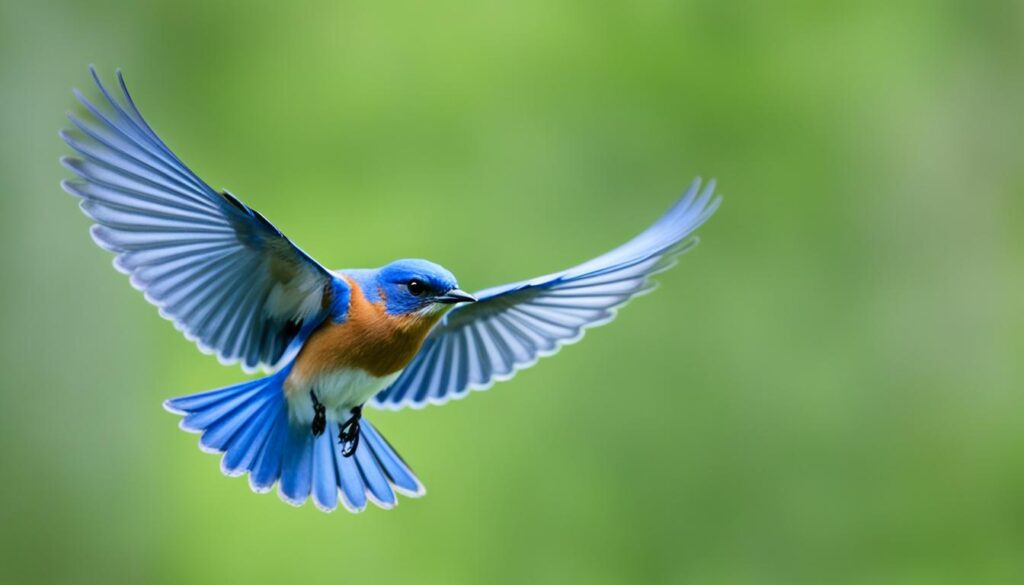
Avian Nutrition: Understanding Bluebird Feeding Habits
Bluebirds change their eating habits with the seasons. In spring and summer, they eat lots of insects. These insects give them the protein and energy they need to care for their babies. When it gets colder and insects are fewer, they start eating fruits and berries. This helps them survive in different places and get the nutrients they need all year.
Seasonal Dietary Changes
In warmer months, bluebird feeding habits focus on insects. They eat caterpillars, beetles, crickets, grasshoppers, and spiders. As fall and winter come, they switch to eating fruits. They enjoy eating berries like mistletoe, sumac, blueberries, and black cherry. This change in diet helps them stay healthy and strong all year.
“Bluebirds’ adaptability in their dietary preferences is a testament to their resilience and ability to thrive in diverse environments.”
Learning about bluebird feeding habits and their avian nutrition needs helps us appreciate their connection with nature. This knowledge lets us create better homes for these birds. It also helps us feed them right, making our backyards a welcoming place for these beautiful birds.
What do blue birds eat?
Eastern Bluebirds eat a wide variety of foods. They love insects, wild fruit, and berries. This makes them key players in their ecosystems.
These birds are great at finding and catching beetles, crickets, grasshoppers, and spiders. They sit high up, then swoop down to grab their food. This diet gives them the proteins and nutrients they need, especially in the warmer months.
Bluebirds also enjoy eating small fruits and berries. These foods give them energy and nutrients, especially when insects are scarce in the cold seasons. Overwintering bluebirds eat berries from plants like mistletoe, sumac, holly, dogwood, and juniper.
Sometimes, they eat bigger things like shrews, salamanders, snakes, lizards, and tree frogs. But mostly, they stick to eating insects, fruits, and berries.
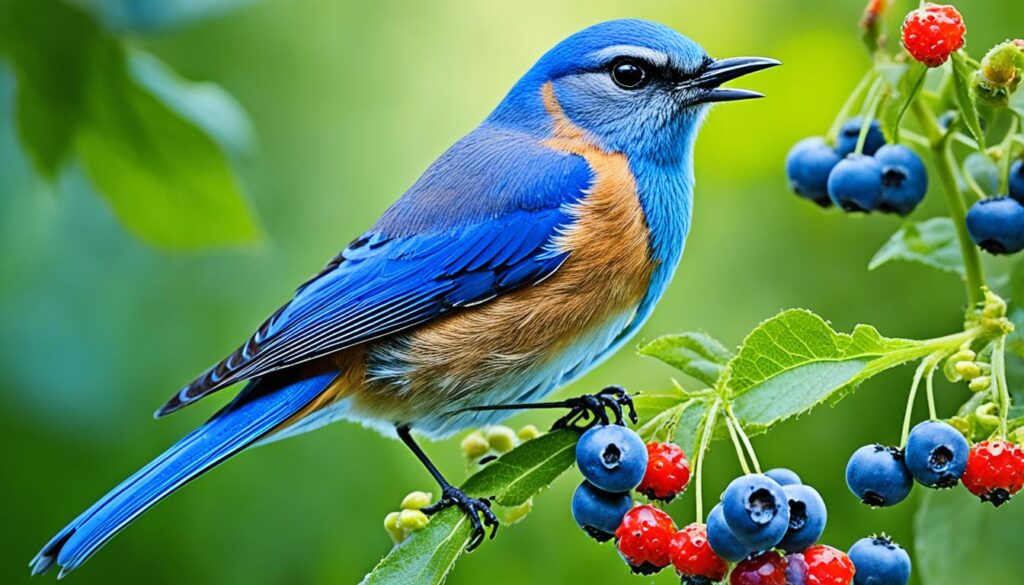
The bluebird diet shows how adaptable they are. It also highlights the need for a balance of insects and plants in their homes. Knowing what bluebirds eat helps us feed them right and support these lovely birds.
Attracting Bluebirds with Nesting Boxes
One of the best ways to bring bluebirds to your yard is by offering them nesting boxes. These birds like to nest in cavities. So, placing and keeping up nest boxes right is key. It greatly affects if bluebirds will make your box their home.
Nest Box Positioning and Maintenance
To draw bluebirds, put nest boxes in open spots with good views. Keep them away from thick plants and busy paths. Cleaning and checking the boxes often helps bluebirds have a good breeding season.
- Place nest boxes in open areas with clear visibility, away from dense foliage and busy pathways.
- Monitor nest boxes regularly, and clean them between breeding seasons to maintain a healthy environment.
- Ensure the nest boxes are well-suited for the local bluebird species, with the right size and design.
By doing these things for your nest boxes, you make a welcoming spot for bluebirds. This helps them nest and breed better on your property.
“Bluebirds start looking for nesting spaces as early as January or February in some areas.”
Supplemental Feeding for Bluebirds
Bluebirds find many natural foods, but extra food helps during tough times. Live mealworms are a hit with them. They love these protein-rich larvae and will visit feeders often.
Live Mealworms: A Favorite Treat
Live mealworms cost about $40 for 10,000, plus shipping, online. They’re packed with protein, from 20% to 48%. In suburbs, bluebirds find extra food helpful. But, avoid giant mealworms as they might harm the birds.
Keep mealworms fresh by storing them in a fridge. Some sellers give discounts to bird groups, making it cheaper to feed your bluebirds.
Bluebirds eat mostly insects but love mealworms in feeders. Feeding them mealworms helps fight off parasites in their nests. A study in northern Minnesota showed that feeding mealworms helped bluebirds survive better.
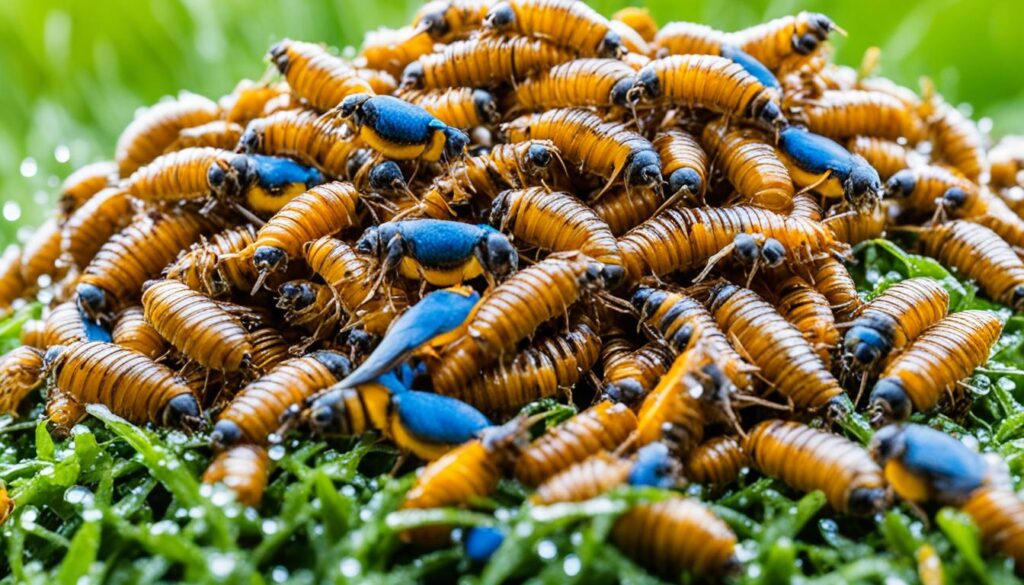
Feeding bluebirds at the right time is key. Feeding early helps them fight off parasites early. Mixing mealworms with suet saves money and gives birds a nutritious snack.
Bluebird Feeders: Types and Considerations
Choosing the right feeder for bluebirds is key. They like open, platform-style feeders that make it easy to get to the food. Tube feeders or those with small perches aren’t as appealing to them.
Where you put the feeder matters too. It should be easy for bluebirds to get to but hard for other birds. Bluebirds like feeders near trees or shrubs. This gives them a clear view and a way to escape.
When picking a feeder, look for one that’s strong, weatherproof, and easy to clean. Bluebirds enjoy different foods like mealworms, suet, fruit, and seeds. Offering a variety keeps them coming back.
Think about when and how often to feed the bluebirds too. They might need extra food in winter when it’s hard to find natural food. Feeding them regularly helps them survive the year.
Establishing a Feeding Routine
Creating a steady bluebird feeding routine is key to drawing and keeping bluebirds to your yard. Bluebirds learn to visit at the same times and spots for food. By feeding them mealworms at the same time and spot every day, you help them get used to a feeding routine.
Timing and Frequency
Feed them at the best times, like when they’re breeding or when food is hard to find. Experts say give about 10 live mealworms per bird, twice a day. That’s around 100 mealworms a day for each feeder once they get used to it.
The National Bluebird Society suggests a pair of bluebirds with babies get about a hundred worms in the morning and evening. This feeding frequency and timing make sure they have steady, nutritious food. It helps their growing families.
“Mealworms are a nutritious food supplement relished by bluebirds, providing necessary moisture for nestlings. Live mealworms are preferred, as freeze-dried mealworms may require rehydration to attract the birds.”
With a steady bluebird feeding routine, you support the local bluebird population. You’ll also get to enjoy their bright colors in your backyard all year.
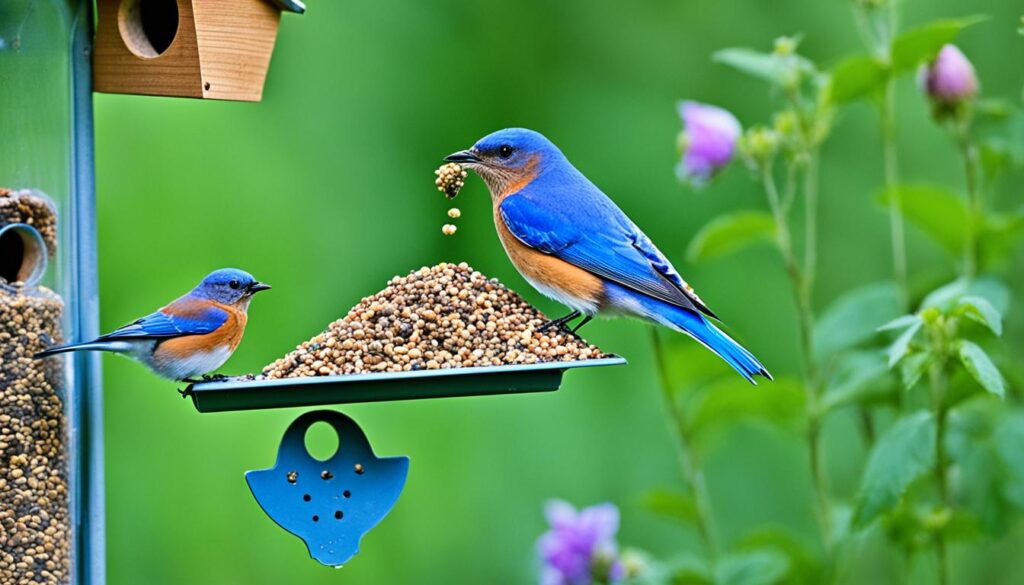
Preventing Other Birds from Stealing Bluebird Food
Feeding bluebirds can be tough because other birds might take their food. Birds like grackles, starlings, or the common house sparrow can easily take over the feeders. This leaves bluebirds without the food they need.
To help bluebirds get the food they need, we must place and design the feeders carefully. We should use things like predator guards or different sized perches. These can make it hard for the wrong birds to get to the food but easy for bluebirds.
- The house sparrow is one of the most common birds in North America. It grew in number quickly after coming from Europe in the 1850s.
- House sparrows are aggressive and can take over bluebirds’ homes and food. This is a big problem for bluebirds.
- Using Gilbertson PVC boxes and the Sparrow Shield can keep house sparrows away from bluebird boxes and food.
By managing the feeder well and using special deterrents, we can make sure bluebirds get the food meant for them. This stops bluebird food competition and preventing bird theft by other birds.
“Keeping food available for bluebirds is key to helping their population. But, it takes careful bluebird feeder management to make sure they get the most out of it.”
Bird Food: Experimenting with Different Options
Live mealworms are a top choice for feeding bluebirds, but there are other foods you can try. Dried mealworms are a good pick because they last longer but might not draw the birds in as much. Suet, a high-energy food made from fat and seeds, is great for cold months when food is hard to find.
Trying different foods can make sure bluebirds get a balanced diet. Bluebird food options like dried mealworms and suet give them important nutrition and energy. This is key when natural bluebird food is scarce.
Dried Mealworms, Suet, and Other Alternatives
- Dried mealworms can be a convenient and long-lasting supplement to a bluebird’s diet.
- Suet, made from rendered fat and seed, can be an appealing option, particularly during the winter months.
- Offering a variety of supplemental feeding alternatives can help diversify the bluebirds’ nutritional intake.
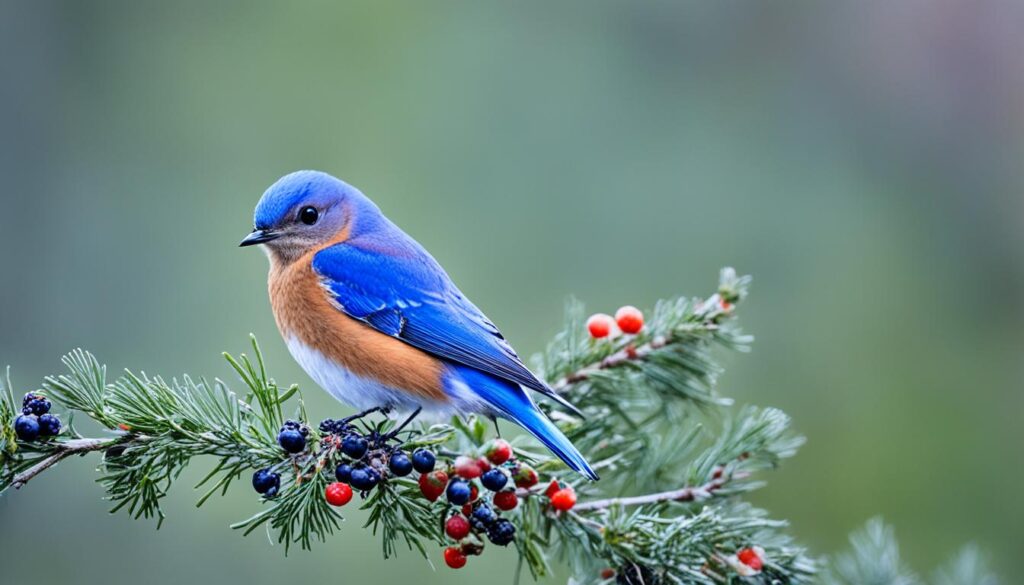
“Experimenting with different types of bluebird food can help ensure they have a well-rounded diet and access to essential nutrients.”
By offering bluebird food options like dried mealworms and suet, you can give bluebirds the extra nutrition they need. This supports their health and happiness.
Location Matters: Positioning Bluebird Feeders
Attracting bluebirds means placing your feeder just right. They like open spots that are easy to get to and far from thick plants and busy areas. Putting your feeder near places where they might nest can make them more likely to stop by for food.
Think about how close your feeder is to others. Bluebirds might not come if they feel like they’re being pushed out by bigger birds. To make it welcoming, keep the bluebird feeder location at least 10 feet away from cover to stop squirrels.
- Feeders close to windows (within 3 feet) are safer to reduce bird collisions with windows.
- Evergreens are great for giving birds a safe place to hide from predators and bad weather.
- Wind can make seeds spill or get wet in the feeder, so choose a spot that’s more protected.
Setting up a feeder might take some time as local birds get used to it. If birds aren’t coming, try putting seeds on the ground nearby to draw them in.
Bluebirds are sweet, gentle, and have bright royal blue feathers.
Training Bluebirds to Recognize Feeding Cues
Bluebirds are smart birds that can learn to recognize certain cues for food. Some people have taught them to come when they hear a whistle or a specific call. This is because they learn to associate these sounds with mealworms or other foods they like.
By always using the same feeding cues when you feed them, bluebirds can learn to come when they hear these cues. This makes them more likely to visit and eat the food you offer. It’s a great way for birdwatchers to connect with these beautiful bluebirds.
A study from 2014 to 2019 showed that supplemental feeding was common in 10% of Eastern Bluebird nests. This highlights the need for extra food during tough times.
“Bluebirds were trained to recognize a cue (kissing sound) for feeding, indicating successful training techniques.”
Using bluebird training methods can help these birds find and use the food you provide. This is good for their health and happiness.
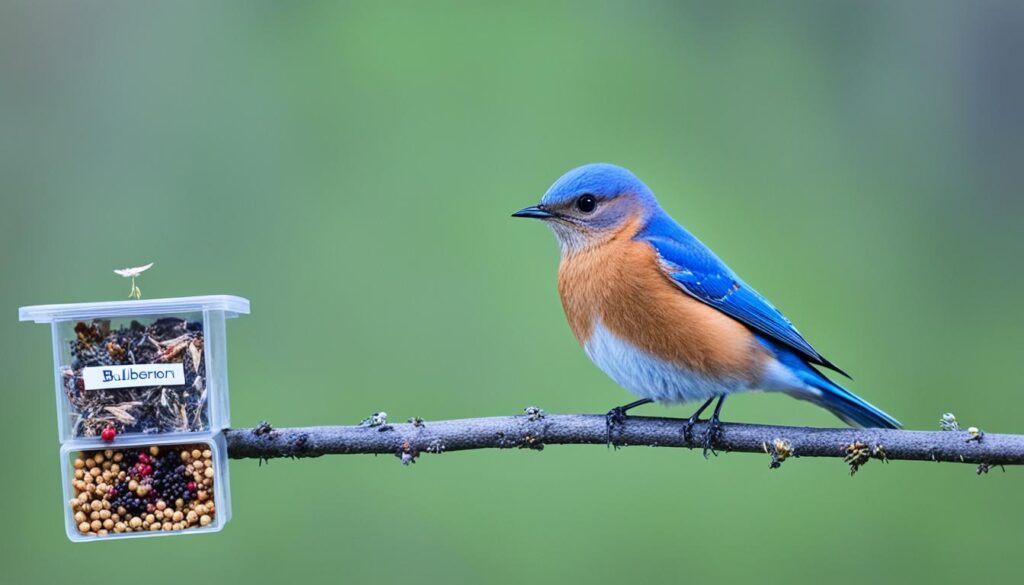
For successful bluebird training, be consistent and patient. Offer the food with a specific cue. This way, bluebirds will learn to come when they hear that sound or see that action. They’ll be more likely to visit your feeders and enjoy the supplemental feeding habits.
The Importance of Moderation in Supplemental Feeding
As bird lovers, we often want to help bluebirds in our yards. Feeding them extra can be a good idea, but we must be careful. Too much food can harm their natural eating habits and make them too dependent on us.
Bluebirds are great at finding their own food, like insects and berries. Their diet is key to their health. We should feed them as a little extra, not as their main food source.
By slowly cutting back on extra food, we help bluebirds keep their natural hunting skills. This is good for them and the whole ecosystem.
“Moderation in all things is the surest path to a thriving bluebird population.”
We should aim for a balance. Extra food should add to their diet, not take over. This way, we can keep enjoying these lovely birds and make sure they stay healthy.
Knowing how to feed bluebirds the right amount helps us create a great home for them. It’s good for the birds and makes our yards more interesting and diverse.
Conclusion
Bluebirds are fascinating and beloved birds that capture the hearts of many. They are found across the United States. To attract and support these birds, it’s key to know their diet and how they forage.
Offering nesting spots, supplemental feeding, and managing your yard can make it a welcoming place for bluebirds. This approach helps create a thriving habitat for them.
It’s important to balance their natural food sources with some supplemental feeding. This way, bluebirds can eat insects, fruits, and berries. With the right knowledge and care, you can enjoy bluebirds in your yard for many years.
This article has given you tips on the bluebird diet, their feeding habits, and how to attract them. By understanding their foraging and nutrition needs, you can support their health and well-being. This makes your backyard a better place for these amazing birds.
FAQ
What do bluebirds primarily eat?
Bluebirds mainly eat insects. These make up a big part of their diet. They enjoy eating beetles, crickets, grasshoppers, and spiders.
Do bluebirds eat fruits and berries?
Yes, bluebirds also eat berries and small fruits. These give them important nutrients and energy. This is especially true in the winter when there are fewer insects.
Are bluebirds considered seed eaters?
No, bluebirds are not seed eaters. Their beaks aren’t good for cracking hard seeds. They prefer softer foods like insects, fruits, and berries.
How do bluebirds’ dietary preferences change throughout the year?
Bluebirds change what they eat and how they forage seasonally. In spring and summer, they focus on insects. In the cold months, they eat more fruits and berries.
How can I attract bluebirds to my backyard?
To attract bluebirds, offer them nesting boxes. They like to nest in cavities. Make sure the boxes are well-placed and maintained.
What type of supplemental food do bluebirds prefer?
Bluebirds love live mealworms. These are high in protein and attract them to feeders.
How should I position and design bluebird feeders?
Use open, platform-style feeders for bluebirds. They should be easy to get to but hard for other birds to reach.
How important is a consistent feeding routine for bluebirds?
A regular feeding schedule is key to keeping bluebirds around. They learn to come to certain times and places for food.
How can I prevent other birds from stealing the food meant for bluebirds?
To keep other birds away, place feeders carefully. Make them hard for unwanted birds to get to but easy for bluebirds.
Are there any alternative supplemental food options for bluebirds besides mealworms?
Besides live mealworms, you can try dried mealworms and suet. Suet is a high-energy food made from fat and seed.
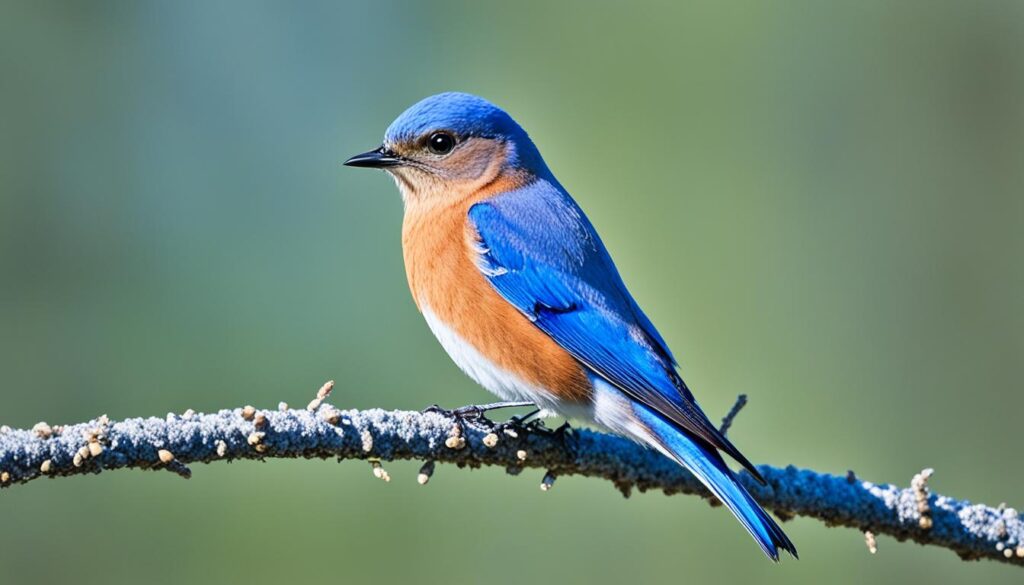

профиль с подписчиками профиль с подписчиками
маркетплейс аккаунтов https://marketplace-akkauntov-top.ru/
перепродажа аккаунтов перепродажа аккаунтов
магазин аккаунтов купить аккаунт с прокачкой
покупка аккаунтов профиль с подписчиками
аккаунт для рекламы kupit-akkaunt-top.ru/
продать аккаунт магазин аккаунтов
Account Trading Platform Account Sale
Gaming account marketplace Buy and Sell Accounts
Website for Buying Accounts Account Buying Platform
Account Trading Service Account Selling Platform
Sell Pre-made Account Buy Account
Account Store Database of Accounts for Sale
Accounts marketplace Account marketplace
Account Selling Platform Buy Account
Profitable Account Sales Online Account Store
Ready-Made Accounts for Sale Account Trading Service
purchase ready-made accounts account buying platform
account trading account catalog
account purchase https://socialaccountssale.com
guaranteed accounts account exchange service
website for buying accounts social media account marketplace
purchase ready-made accounts profitable account sales
secure account purchasing platform sell pre-made account
gaming account marketplace account exchange service
account acquisition account purchase
profitable account sales secure account sales
sell pre-made account marketplace for ready-made accounts
sell accounts account catalog
account buying service account trading platform
account trading platform account catalog
account market account trading service
accounts for sale account purchase
buy account account buying service
buy pre-made account secure account sales
purchase ready-made accounts buy account
guaranteed accounts buy pre-made account
account purchase account trading platform
sell pre-made account account buying service
account market account sale
account purchase gaming account marketplace
accounts market sell account
website for buying accounts website for selling accounts
ready-made accounts for sale account trading platform
sell pre-made account website for buying accounts
buy account https://accounts-offer.org/
account marketplace https://accounts-marketplace.xyz
account trading platform buy-best-accounts.org
buy accounts https://accounts-marketplace.live
buy and sell accounts https://social-accounts-marketplace.xyz
database of accounts for sale https://buy-accounts.space
secure account purchasing platform https://buy-accounts-shop.pro/
verified accounts for sale https://social-accounts-marketplace.live
account catalog https://buy-accounts.live/
account market https://accounts-marketplace.online/
account selling service https://accounts-marketplace-best.pro
продажа аккаунтов https://akkaunty-na-prodazhu.pro
продать аккаунт rynok-akkauntov.top
купить аккаунт https://kupit-akkaunt.xyz/
биржа аккаунтов https://akkaunt-magazin.online/
маркетплейс аккаунтов соцсетей akkaunty-market.live
маркетплейс аккаунтов соцсетей https://kupit-akkaunty-market.xyz
маркетплейс аккаунтов https://akkaunty-optom.live/
купить аккаунт маркетплейсов аккаунтов
биржа аккаунтов akkaunty-dlya-prodazhi.pro
маркетплейс аккаунтов соцсетей kupit-akkaunt.online
facebook ad accounts for sale https://buy-adsaccounts.work/
facebook accounts to buy https://buy-ad-accounts.click
facebook ad account buy https://buy-ad-account.top/
buy facebook advertising https://buy-ads-account.click
facebook ad account for sale cheap facebook account
buy facebook account facebook ad account buy
buy facebook ads account https://ad-account-for-sale.top
buy aged facebook ads accounts https://ad-accounts-for-sale.work
buy adwords account google ads accounts
google ads account seller https://buy-ads-accounts.click
facebook ad account buy https://buy-accounts.click
buy google agency account https://ads-account-for-sale.top
buy google ads agency account google ads accounts for sale
buy google ad account https://buy-ads-invoice-account.top
google ads account buy https://buy-account-ads.work
google ads agency account buy https://buy-ads-agency-account.top
buy verified google ads accounts https://sell-ads-account.click